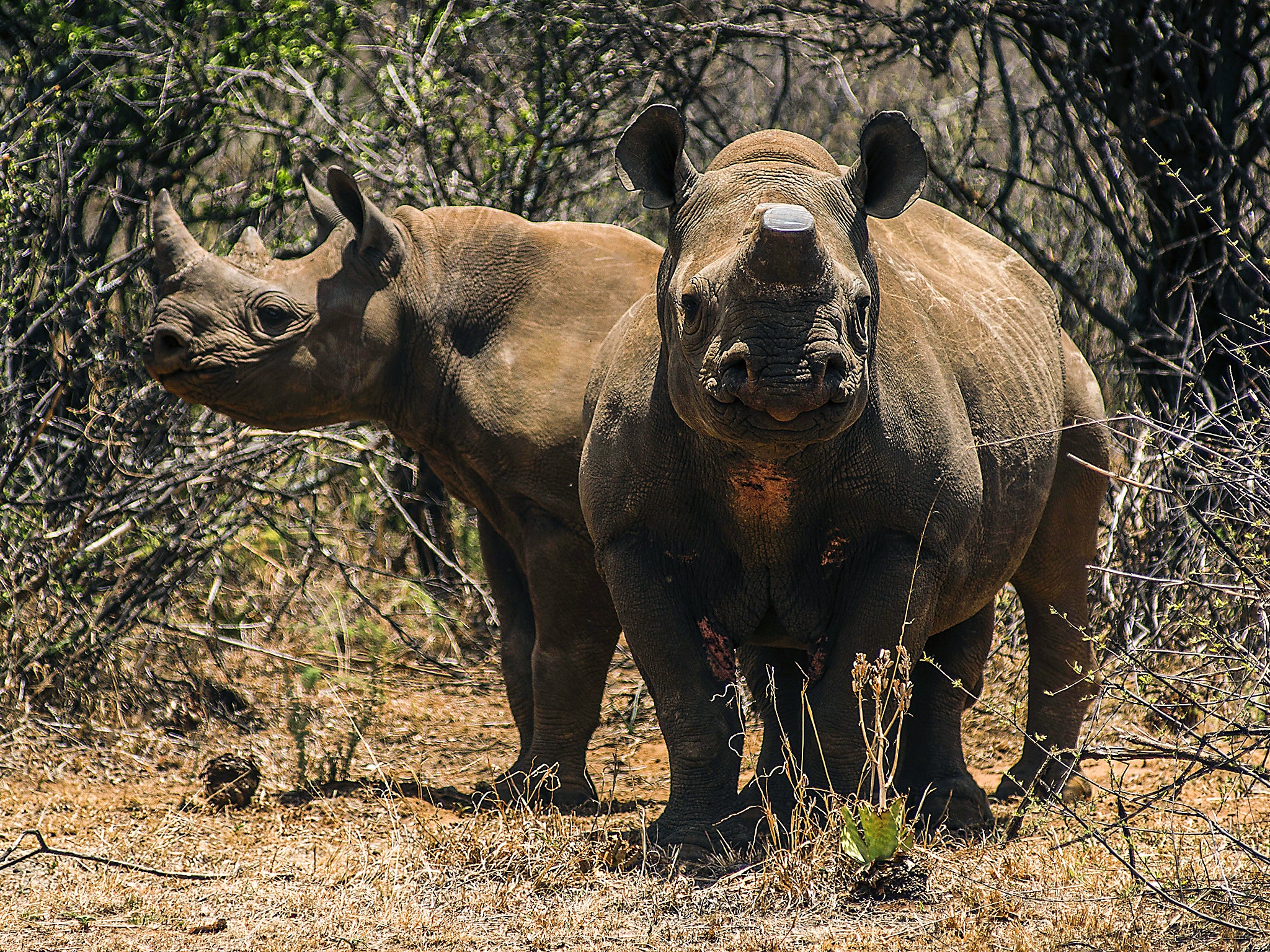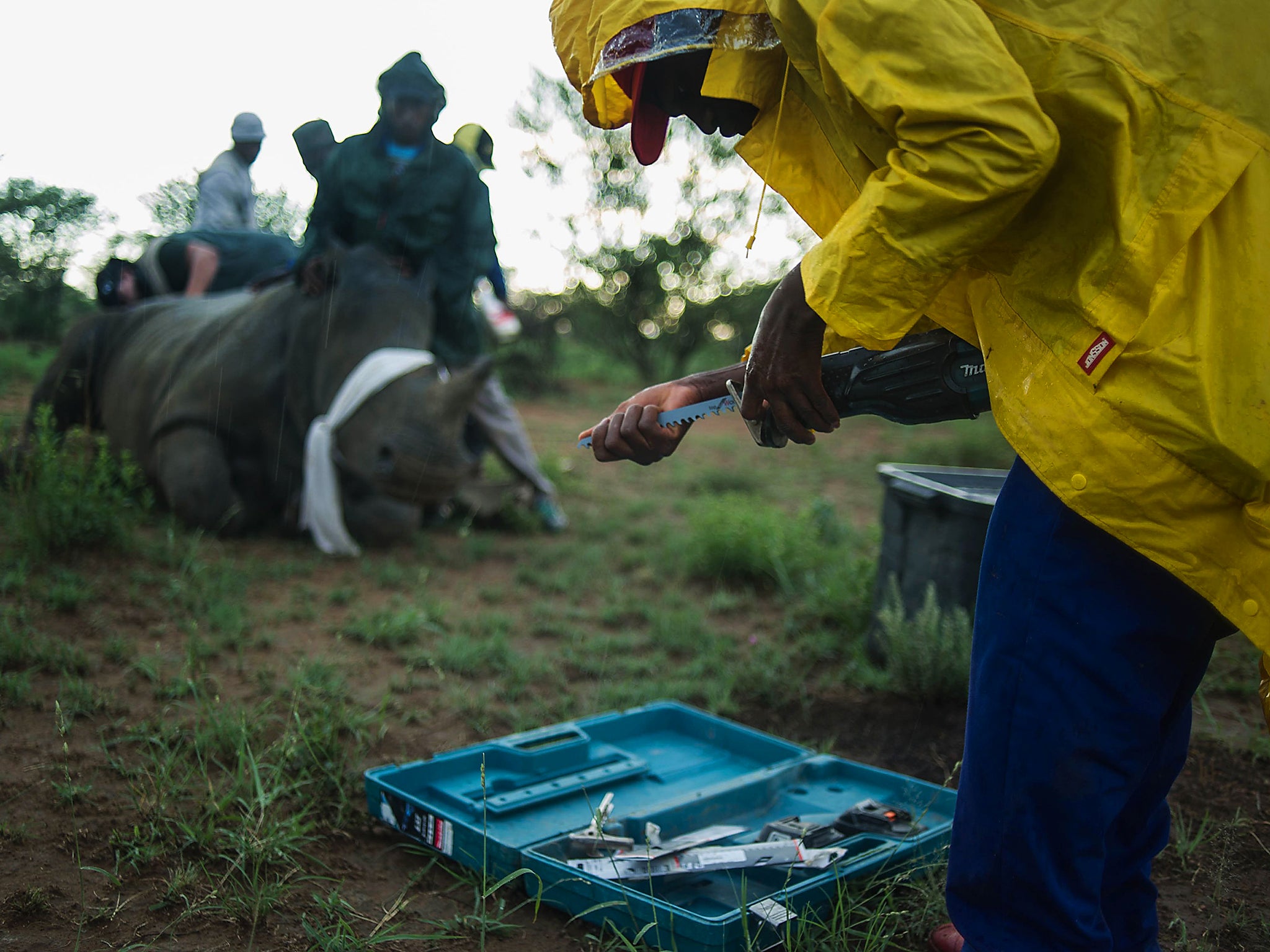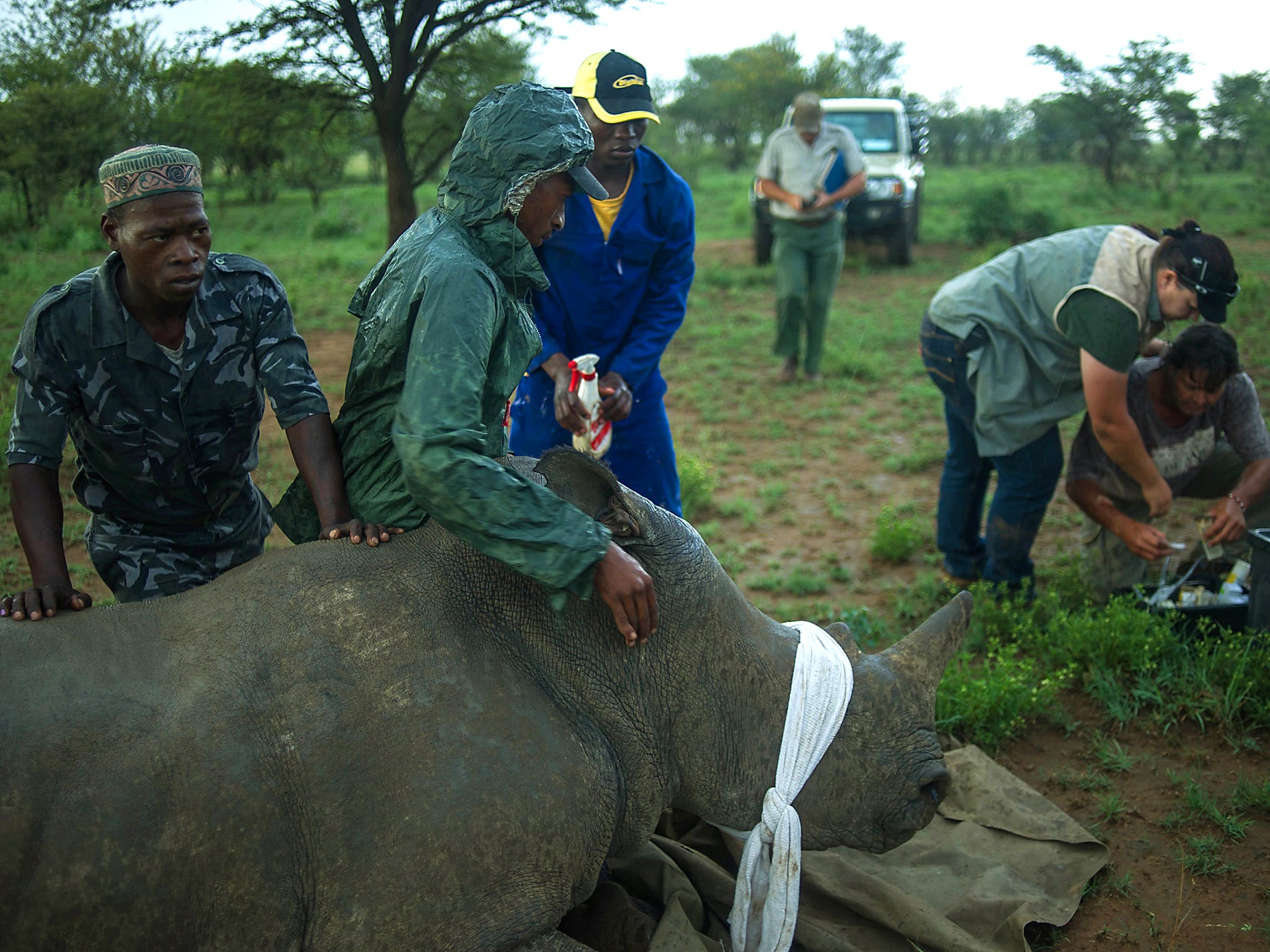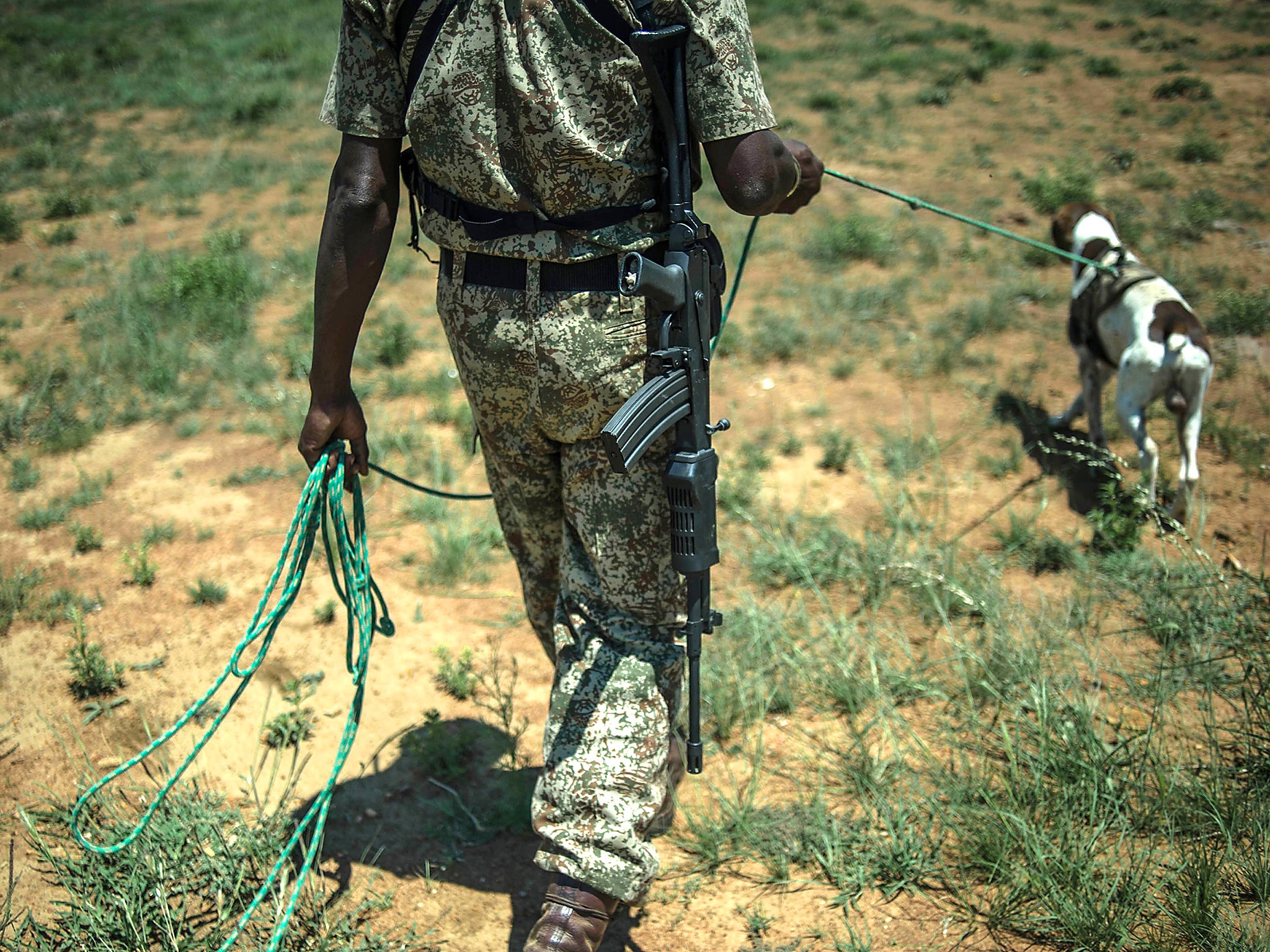Horns of a dilemma: legal trade in rhino horn could save the species
South Africa is home to 80 per cent of the world’s rhinos, and all are under siege by increasingly sophisticated and militarised poachers

Your support helps us to tell the story
From reproductive rights to climate change to Big Tech, The Independent is on the ground when the story is developing. Whether it's investigating the financials of Elon Musk's pro-Trump PAC or producing our latest documentary, 'The A Word', which shines a light on the American women fighting for reproductive rights, we know how important it is to parse out the facts from the messaging.
At such a critical moment in US history, we need reporters on the ground. Your donation allows us to keep sending journalists to speak to both sides of the story.
The Independent is trusted by Americans across the entire political spectrum. And unlike many other quality news outlets, we choose not to lock Americans out of our reporting and analysis with paywalls. We believe quality journalism should be available to everyone, paid for by those who can afford it.
Your support makes all the difference.Wobbling left, then right, the two-ton animal stumbles and starts to fall. Twelve pairs of hands are there to ease it toward the dusty orange earth. A man wearing a blue work suit quickly straps an eye mask over the now-sedated beast; another slips in a pair of massive earplugs. A few measurements are taken, and then the reciprocating saw comes out. A worker turns it on and presses the whirring blade against the base of the rhino’s nubby horn, and white chips go flying.
Within a couple of minutes, the horn cleanly pops off, leaving behind a teardrop-shaped pattern of pink, white and black keratin – a biological material also found in hair and nails. Mission completed, Michelle Otto, a wildlife veterinarian, gives the rhino an injection – an antidote to the sedative she darted it with 10 minutes earlier. The team scrambles into two pickup trucks, and the rhino – its nose now sporting a stubby plateau rather than a peak – stumbles to its feet and trots off.
This procedure might strike an outsider as strange, but for workers here it’s nothing exceptional. Located 100 miles outside of Johannesburg in South Africa, the nearly 20,000-acre property, owned by a man named John Hume, is the world’s largest rhino ranch. Along with giraffes, sables and other animals, more than 1,400 rhinos call Hume’s Buffalo Dream Ranch home. Every 18 months, Hume’s animals undergo a painless procedure like the one performed today (it takes about that long for the horns to grow back). An average 13 dehornings take place two or three days a week. The horns are immediately microchipped and delivered by an armed escort to an undisclosed off-property location guarded by a private security company. Over the years, Hume has amassed some five tons of horn, which sits in his vault, and an additional ton is added each year. Someday soon, he hopes to be able to sell it all.

South Africa is home to approximately 80 per cent of the world’s rhinos. A third of those 20,000 animals belong to private owners such as Hume. Whether they live in a national park or on a private reserve, however, all rhinos are under siege by increasingly sophisticated and militarised poachers eager to get their hands on their lucrative horns. Unlike the rhinos dehorned on Hume’s ranch, those that cross paths with poachers do not walk away. Faces hacked off, they are left to die.
The horn is often smuggled to Vietnam or China, where it is highly prized by some. A wealthy individual may wear rhino horn jewellery, serve guests from cups made from the material, or prominently display an illegal rhino horn at home or work. Others use it as a purported cure for cancer, a party drug, or in traditional Chinese medicine. Though it is illegal to sell rhino horn both internationally and domestically in Vietnam and China, demand remains high, and as a result, the animals continue to be slaughtered. South Africa lost 1,175 rhinos last year and more than 6,000 since 2009. The government has received financial assistance from the US and anti-poaching donations in the millions from the likes of Warren Buffett’s son, but private rhino owners such as Hume bear the costs for protecting their animals. A burly, big-bellied 74-year-old with a bushy white beard, Hume says he “stupidly” fell in love with rhinos in 1993, when he purchased his first animal to kick-start his dream of spending retirement running a ranch. “I became aware of what wonderful natures they have but also that they’re facing extinction,” he says. “I thought the best way to make a difference is to breed them, and as a result, I have slowly but surely gotten myself into one hell of a corner.”
Hume spends around $175,000 (£140,000) per month on anti-poaching operations. He hasn’t lost a rhino in nine months, but he says the spending involved in achieving that success is not sustainable. Owning rhinos also puts him and his family in a vulnerable position. Private rhino owners and staff have been raped, stabbed and attacked by poachers trying to steal stockpiled horns. While 330 South Africans still keep rhinos on their property, 70 others have given up their animals in the past two years. As the difficulty and expense of keeping rhinos intensify, 85 per cent of the private owners – in addition to some conservationists, academics and government experts – have come to believe that legalising the rhino horn trade is the only way to save the species from extinction.

South Africa has a stash of more than 30 tons of horn, some of it intercepted from the black market, according to the Private Rhino Owners Association (PROA), a non-governmental group in South Africa (a 2014 study by South Africa’s Department of Environmental Affairs put the country’s total figure at 3.6 tons, however). Trade proponents argue that legalising rhino horn would satiate demand and collapse black markets while simultaneously providing much-needed funds for anti-poaching efforts and rhino conservation. Private breeders say they could collectively produce around 10 tons per year. But conservationists point to a hole in this logic: there’s no proof that poachers will stop killing rhinos. Many owners agree that legalisation won’t provide all of the answers. Strict law enforcement is also important, they say. “None of us bought rhino because we wanted to get into the rhino horn trade; we bought rhino because we’re rhino conservationists,” says Pelham Jones, chairman of PROA. “But if we can take pressure away from wild populations by selling off stockpiles, that will give us key years to secure populations and start to achieve some degree of market control.”
Selling rhino horn was once legal in South Africa. In 2006, for example, Hume sold 185 pounds for $83,250. But in 2009, the government put a moratorium on the trade, a move that some say harmed the animals it was meant to protect. “If demand is increasing, as it has over the last 10 years, and you don’t supply the market, then someone else is going to supply the market,” says Michael ’t Sas-Rolfes, a conservation economist and doctoral candidate at the University of Oxford. “That’s why we’ve seen a radical increase in poaching and illegal trade.”
The moratorium may end soon. Many rhino owners assert that it violates South Africa’s constitution because the government did not follow due process and because the moratorium blocks owners’ rights to sustainable use of wildlife. In 2012, Hume and another rhino owner brought a lawsuit against the government on these grounds, and so far the courts have ruled in their favour. A decision on an appeal is expected any day. “I have 100 sets of horns that I hope to have on auction within six weeks after a favourable result,” Hume says. The price, he guesses, would be about $4,500 per pound – 10 times what it was in 2006. Others vehemently argue that South Africa is incapable of controlling legal rhino horn trade. “The corruption here is absolutely enormous: We’ve got pilots, rangers, policemen, government officials and veterinarians involved [in poaching and illegal trade],” says Allison Thompson, director of the nonprofit Outraged South African Citizens Against Rhino Poaching. Crawford Allan, senior director of TRAFFIC (a wildlife trade-monitoring network) at the World Wildlife Fund, says legally-sold horns would create a smokescreen for poached horns. “The systems are not in place to secure the sales or supply, and the cost of poaching and trafficking is always going to be far cheaper than the sale of legal horn,” he says. Rhino keepers pay for land, veterinarians and protection; poachers pay for a few days of manpower and a vehicle. Thus, the price of an illegal horn would always be lower than a legal one, he says. “We’re not dismissing all trade in rhino horn forever, but right now it would be a disaster to legalise it.”

One of the biggest concerns, Allan continues, is growing the consumer base. Legalising rhino horn would send the message that it is a socially acceptable product, causing the market to expand to include those who can afford and do want rhino horn but refrain from buying it because they do not want to break the law. Research conducted by the Natural Resources Defense Council in 2014 on consumer preferences in China confirmed this is a threat. “I’m not at all opposed to trade under the right conditions, but I can tell you that the latent demand in China for rhino horn is much higher than what could be produced by farms and other available supply,” says Alexandra Kennaugh, the study’s principal investigator. Dex Kotze, founder of the South Africa-based nonprofit Youth 4 African Wildlife, agrees that the numbers do not add up. “If one per cent of people in China, Vietnam and Thailand use 1 gram of rhino horn per year, then the demand is nearly 15 tons,” he says. “If it’s 5 per cent, then it’s 372 tons – it’s massive.” He adds that those calculations do not take into account possible dormant markets in Japan, Singapore, the Middle East and other places where rhino horn was historically used.
How legal trade in South Africa would logistically work is still being discussed. Some have proposed opening rhino horn clinics that cater to Asian tourists and expatriates; others of developing a carving industry. That some or even most of the rhino horn legally sold in South Africa would likely make its way illegally to Asia – and that the very criminals currently behind the killing of rhinos may be involved – is not a deal breaker. “Morally, it is a huge concern to work with those individuals, but if we have to do business with the devil to ensure species survival, then so be it,” Jones says. He adds that it is the government’s responsibility to stop horn from leaking out of the country. It remains illegal to sell rhino horn internationally or to import it into any of the 183 countries that are signatories to a treaty called the Convention on International Trade in Endangered Species of Wild Fauna and Flora (CITES).

Ultimately, it is impossible to predict how things will play out should the rhino owners win their suit, but what little evidence does exist is not reassuring. In 2008, CITES allowed several African countries to conduct a one-time sale of over 100 tons of ivory – another wildlife product banned from international trade – to China and Japan. Anecdotal evidence, recently supported by a working paper published by economists in the US, indicated that the sale exacerbated the killing of elephants, likely because it stimulated demand and provided an easy means for laundering. Immediately after the sale was announced, poaching increased by 66 per cent and smuggling by 71 per cent, according to the analysis. While the ivory findings are not directly applicable to rhino horn, the paper’s lead author, Solomon Hsiang, chancellor’s associate professor of public policy at the University of California, Berkeley, thinks there are some potential takeaways, including that meeting demand for rhino horn without stimulating poaching could be even more challenging than ivory. Unlike ivory, rhino horn is often consumed, so more is needed on a rolling basis. “Once these large stashes of rhino horn are gone, you’d have to be ready to do mass production – which I don’t think we are ready for – or else other suppliers are going to come in and poach,” Hsiang says. Such uncertainties do not sit well with many conservationists. As Allan says, “We can’t experiment with rhinos, because there are too few of them left.”
But whether he and others like it or not, a large-scale, real-world experiment is looming. Hume and others are unwavering in their belief that this seemingly unavoidable experiment will prove them right. “I’m telling you, I am not wrong,” he says. “And knowing rhinos, I am convinced that they would be very happy to make this small sacrifice to steer their species away from extinction.”
© Newsweek
Join our commenting forum
Join thought-provoking conversations, follow other Independent readers and see their replies
Comments